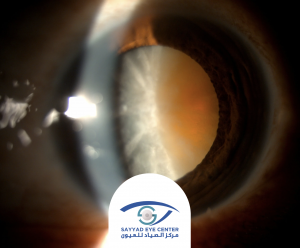
Cataract Surgery
Cataracts can develop from normal aging, from an eye injury, from previous eye surgery or if you have taken certain medications. Cataracts may cause blurred vision and glare, and/or ghost images. If the cataract interferes with your daily life, the cataract may need to be removed. Surgery is the only way to remove a cataract. If you do not have the surgery, your vision probably will not improve and may continue to get worse.
You are more likely to develop cataracts if you have any of these risk factors:
- Too much sunlight exposure
- Smoking
- Obesity
- High blood pressure
- Excessive alcohol consumption
Symptoms
- Clouded, blurred or dim vision
- Impaired night vision
- Sensitivity to light and glare
- Seeing “halos” around lights
- Frequent changes in glasses prescriptions
- Fading or yellowing of colors
- Double vision in a single eye
The different types of cataracts include:
- Age-related cataract: Most cataracts are related to aging.
- Pediatric cataract: Babies that are born with cataracts and they sometimes need to be removed within a few weeks.
- Secondary cataract: Cataracts are more likely to develop in people who have certain other health problems, such as diabetes or those who take steroids chronically.
- Traumatic cataract: Cataracts can develop after an eye injury, or years later.
Tests
You will need to come for an eye exam to be able to determine your diagnosis and tests will need to be done to accurately decide which lens is best for you. You will also need a dilated exam during your visit.
Treatments
Cataract Extraction Surgery
Surgical removal of a clouded lens is considered the best, most successful treatment for this condition. We use the latest technology using ultrasound energy to break your cataracts into small pieces which is removed through a very small incision.
Similar to prescription glasses or contact lenses, the lens that is implanted in the eye is chosen to match the patient’s visual needs. If you have astigmatism, your surgeon may correct it with using a special type of lens “ Toric lens” or another procedure such as LASIK or a limbal relaxing incision (LRI) to reshape your cornea. Your doctor will guide you in choosing the intraocular lens that is right for you, depending on your condition and preferences.
Lens options include
Intraocular Lenses – Whether surgery is done to remove cataracts or to correct farsightedness, various replacement lenses are available.
Monofocal IOLs
These are the traditional lenses that provide clear vision for one distance, and they are typically chosen for distance vision. This means you’ll need glasses for reading or close-up work. There’s another type called Monofocal Plus, which can sometimes help with seeing larger letters at intermediate distances
Toric IOLs
Toric lenses correct astigmatism, which causes blurry vision. They provide clearer distance vision for people with astigmatism, but you might still need glasses for close-up vision.
EDOF IOLs (Extended Depth of Focus)
Extended Depth of Focus lenses are among the newest types of lenses and are suitable for a wider range of patients. They provide clear vision from distance to intermediate, making them ideal for tasks like using a computer. However, you might still need glasses for very close-up vision.
Trifocal IOLs
Trifocal lenses provide clear vision for near, intermediate, and distant distances. They offer freedom from glasses but may cause some halos around lights, especially at night. This type of lens requires careful patient selection to ensure the best results.

